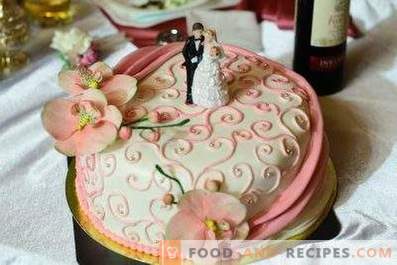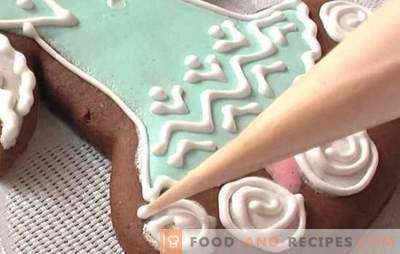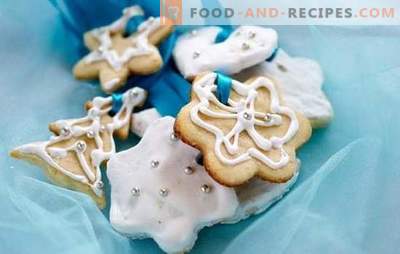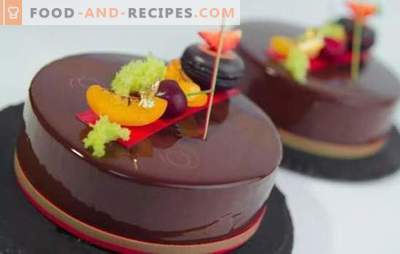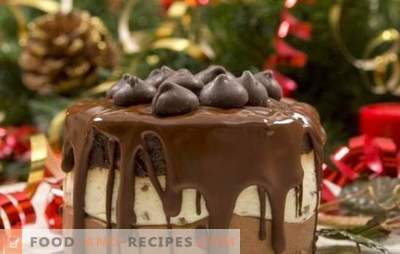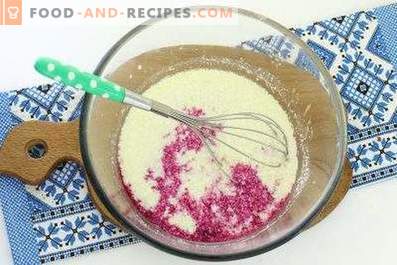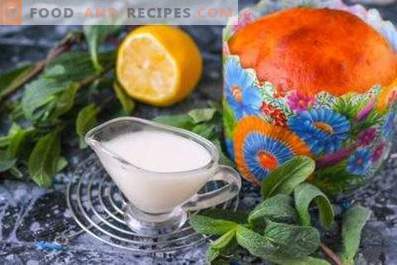
Inexperienced hostesses diligently choose the recipe for the dough for the Easter cake, but sometimes it is too late to remember what they will cover it with. Without watering, even the most delicious cake will look pale and unappetizing. In order not to get into an unpleasant situation, it is worthwhile to decide in advance what kind of icing for the cake you will make, to prepare the necessary products.
Cooking Features
Fudge for the cake can be made according to different recipes and from different products. The technology of preparation of such coatings can also have significant differences. However, there are several general rules that it is better not to break if you want to get a perfect result.
- Frosting to cover the Easter cakes is usually prepared on the basis of powdered sugar. You can use the finished product or make it yourself from sugar. To do this, it is enough to grind with a blender or coffee grinder. Home-made powdered sugar will cost less than purchased.
- Regardless of whether you made icing sugar at home or purchased it in a store, you must sift it before using it to make a glaze. This will save her from lumps, so that the fudge will come out smooth.
- If you want the fudge to crumble and not crack, choose a glaze recipe that includes gelatin or other similar thickeners. You can make and cover for the cake from marshmallows.
- Most often, they use protein fudge to cover the cakes, which is inexpensive and easy to prepare. However, this glaze has a significant drawback - a short shelf life: it is desirable to use the coated kulich within 24 hours.
- Most often, for Easter cakes, white glaze is used, but to make baking a brighter and more festive look, fudge can be tinted. To do this, use food gel dyes or juices of fruits and vegetables.
- The use of citric acid or lemon juice will make the sweet taste more pleasant.
- In order for the glaze to keep well on the cake and lay on it in a dense layer, it is coated with fondant in 2 layers. The first layer is applied with a brush and the second is made thicker.
- Confectionery icing hardens quickly, so it should be applied immediately after preparation.
- They put icing on already cooled cakes, so it is not advisable to do it in advance.
- Glaze can be applied with a brush, spoon. Sometimes the cake is just dipped in fudge. Some hostesses use a syringe or pastry bag to apply the glaze, which allows not only to cover the cake, but also to make patterns on it.
- For decorating Easter cakes, they often use confectionery dressing or chopped nuts. Sprinkle the product with them immediately after applying the glaze. If this is done already after the fudge froze, they will not stick.
There are many variants of watering for cakes, each cook will be able to choose the one that meets his gastronomic and aesthetic preferences.
White glaze

Composition:
- egg whites - 2 pcs .;
- icing sugar - 0, 2 kg;
- salt - a pinch.
Preparation Method:
- Wash eggs with soap. Break them by separating the whites from the yolks. Proteins put in a clean and dry container, pre-cooled.
- Add salt to proteins.
- Beat whites with a mixer until resistant peaks. It is desirable to whisk first, at low speed, then gradually increase it.
- Continuing to beat the whites, start pouring sugar over the spoon.
Protein glaze turns out to be viscous, has a glossy shine, it lays well and keeps its shape for a long time.
A simple recipe for icing
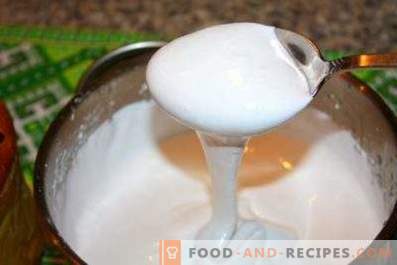
Composition:
- powdered sugar - 100 g;
- milk - 60-80 ml.
Preparation Method:
- Sift sugar powder.
- Add a spoonful of milk to the powder, stirring the composition each time until smooth.
If the icing sugar is too thin, add more icing sugar. Instead of milk, you can use lemon juice.
Simple colored icing
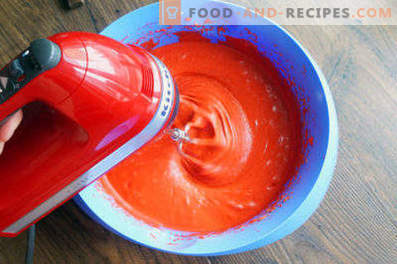
Composition:
- powdered sugar - 0, 2 kg;
- berry juice - how much will leave (about 100 ml).
Preparation Method:
- Grind the frozen berries with a blender, squeeze the mashed potatoes through a thin cloth or folded gauze.
- Dip the icing sugar in a bowl. Add 4 tablespoons of berry juice to it, pound until smooth.
- In a spoon, add the juice and rub the fudge until it reaches the desired consistency (like thick sour cream).
The glaze made according to this recipe has a pink color. The cakes covered with it look very elegant.
Pink beet frosting
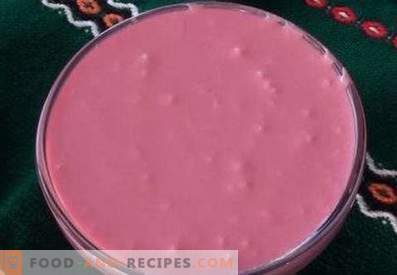
Composition:
- powdered sugar - 0, 2 kg;
- beets - 150 g;
- egg white - 1 pc .;
- lemon juice - 20 ml.
Preparation Method:
- Wash and peel raw beets. Grind it grated with small holes.
- Place the beet puree in a sieve covered with gauze folded in several layers. Strain, squeeze out leftovers. The resulting beet juice set aside.
- Whisk the egg white. Continuing to beat, enter parts of icing sugar.
- Add lemon juice, whisk together with them.
- Add a spoonful of beetroot juice, whisk, or just stir well. Rate the color of the resulting glaze. If it seemed pale, add a little more beet juice, mix.
As soon as the color of the fudge appears to you to be sufficiently saturated, stop adding vegetable juice.
Try not to overdo it with beet juice - it can give a specific flavor to baking, which not everyone likes.
Chocolate icing
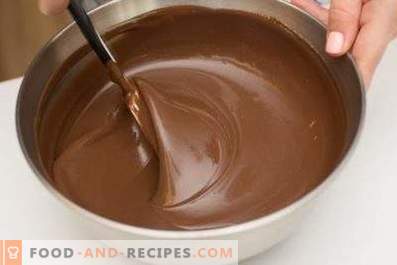
Composition:
- cocoa powder - 50 g;
- fine sugar or powdered sugar - 100 g;
- boiled cooled water - 50 ml;
- butter - 50 g;
- orange liqueur or syrup - 10 ml.
Preparation Method:
- Cocoa mix with sugar. Place this mixture in a small dipper.
- Add water, mix.
- Add sliced butter.
- Put the ladle on slow fire. Heat its contents, stirring until it turns into a homogeneous mass and thickens.
- Remove glaze from heat, mix with liqueur or syrup.
After cooling, the icing will be much thicker. It is advisable to keep the cake covered in the fridge so that the butter, which is the basis of the fudge, does not melt.
Glaze with gelatin
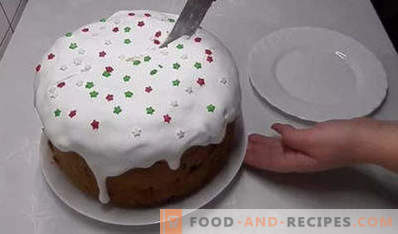
Composition:
- sugar or powdered sugar - 0, 2 kg;
- gelatin - 5 g;
- water - 120 ml.
Preparation Method:
- Pour the gelatin into the cup, cover it with two tablespoons of boiled water, after cooling it to room temperature.
- Mix sugar with remaining water.
- Heat the sugar container by stirring its contents until the sugar is completely dissolved.
- Bring the syrup to a boil and immediately remove from heat.
- Add swollen gelatin to the hot syrup. Stir syrup to achieve complete dissolution of gelatin in it.
- Pour the syrup into a container in which it is convenient to beat the products with a mixer.
- Turn on the mixer. Beat the syrup until it is white and thick.
So that the gelatinous glaze does not thicken too early, it can be put in a cup, and that one can be put in a bowl with hot water.
Chocolate glaze with gelatin
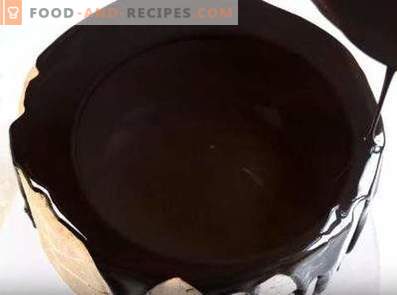
Composition:
- cocoa powder - 60 g;
- cream with a fat content of at least 30% - 100 ml;
- water - 180 ml;
- gelatin - 10 g;
- sugar - 150 g.
Preparation Method:
- Cocoa sift so that there are no lumps in it.
- Mix cream with an equal amount of boiled water.
- The remaining water, cooled to room temperature, pour gelatin, leave it to swell.
- Pour sugar in a small saucepan, pour in diluted cream.
- Heat the cream over low heat, stirring until they are ready to boil. Sugar by this time should be completely dissolved.
- Add to cocoa cream, mix thoroughly, trying to avoid the formation of lumps.
- Add gelatin, mix. Cook a minute.
- Pass the icing through a sieve to make sure that there are no lumps in it or to get rid of them, if any.
Glazes allow to cool to about 35 degrees. At this temperature, it is best placed on the baking surface.
Glaze from marshmallows
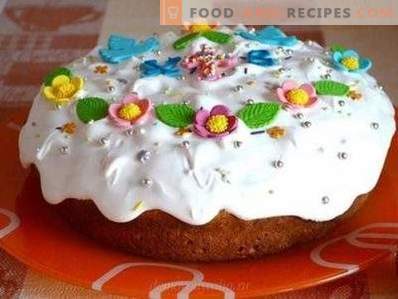
Composition:
- marshmallow - 100 g;
- icing sugar - 0, 25 kg.
Preparation Method:
- Marshmallow put in a container suitable for use in a microwave oven or convenient for heating in a water bath.
- Place the container with marshmallows in the microwave. Turn it on for 30 seconds. Stir the contents of the container. If necessary, heat the marshmallow more. As a result, it should become completely soft and increase in volume. If you do not have a microwave, you can warm up the marshmallows in a water bath.
- Add 150 g of powdered sugar to the marshmallow, mix with a spoon.
- Put the sweet mass on the table. Add to it the remaining icing sugar and knead with your hands, like dough.
- When the mass stops sticking to the hands, roll it to the desired size and cover it with a cake.
Mastic from marshmallows can be used not only instead of glaze, but also to decorate the cake: it is easy to form roses and other figures. Rolling out a sweet mass, it is possible to cut out church domes, birds, and other figures from it. By adding a few drops of gel dye, you give the mastic the selected shade.
Glaze for Easter cakes can be made from protein, powdered sugar, marshmallows. To add sweets to different shades, they use berry, fruit and vegetable juices, cocoa, food colors. To make the confectionary watering more plastic it is prepared with the addition of gelatin. The choice of recipe depends solely on the preferences of the hostess preparing the festive cake.

